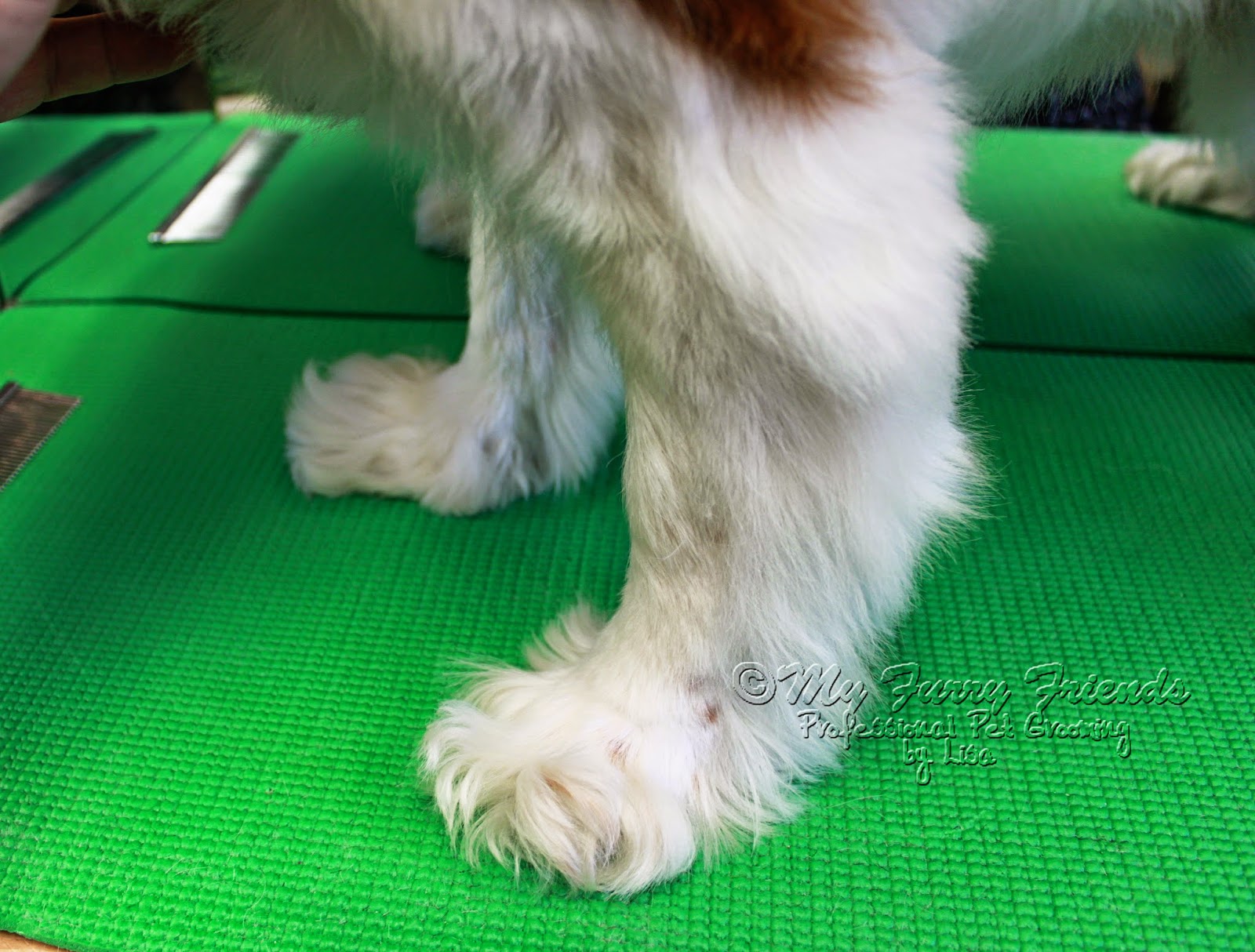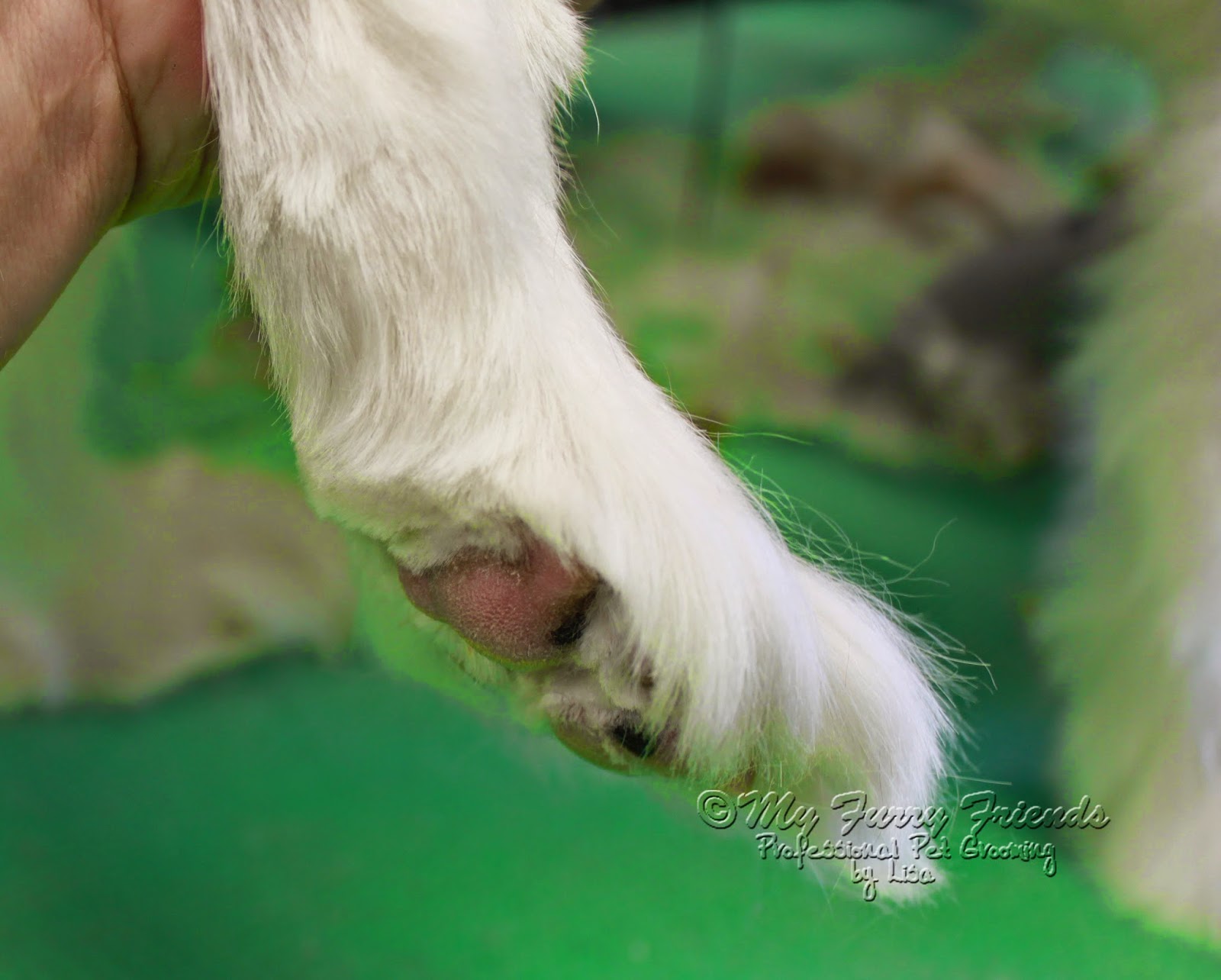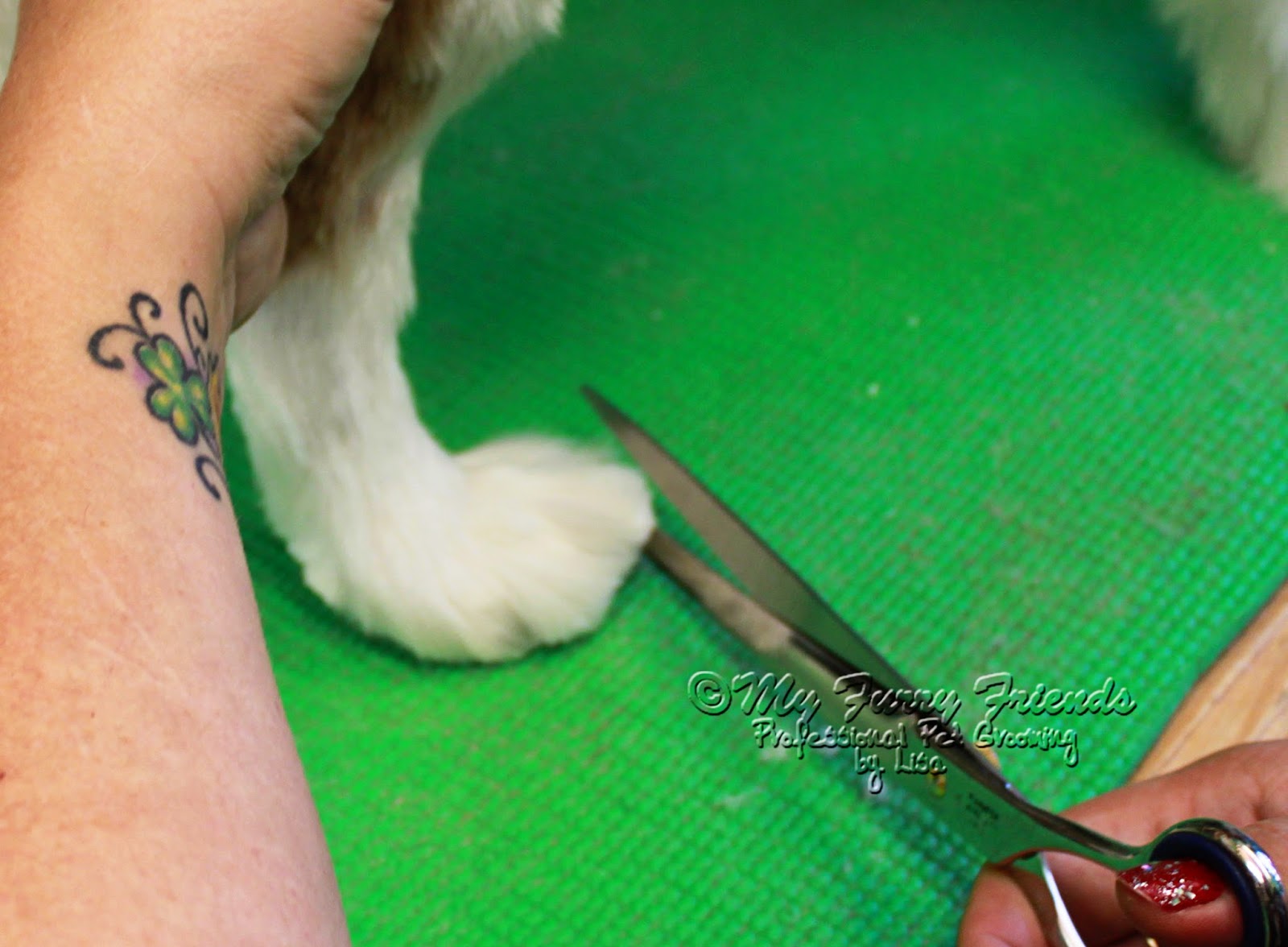I had a blog reader ask a question about getting a smooth clip on a dog.
How to keep from having the blade leave lines in the coat.
I was going to answer her question in the comments, but then thought that showing pictures may help better.
First of all, if you are having trouble getting a smooth look on just a few dogs here and there, the problem could just be the coat type on that particular dog.
Every once in awhile I will come across a coat that is very frustrating to get a nice smooth look on.
Sometimes it is almost impossible to do with the clipper blade and I would have to follow up with scissors and thinning shears to smooth out the clip.
I know that some groomers out there like to use blades in reverse to get a nice smooth clip on a dog.
I am personally not crazy about reverse clipping.
I think it damages some coats.
I also think that there is more of a chance of clipper irritation when reverse clipping.
I feel that some dogs do not like the feel of the blade running backwards against the grain of their coat.
Reverse clipping, depending on the blade that you use, may also take the coat a lot shorter than the owner wanted.
As I stated, these are just my own opinions.
I am much more comfortable clipping with the grain on a dogs coat.
That being said....clipper lines....
If you are having problems with clipper lines on every dog that you clip, look at your equipment first.
Are your blades sharp?
Are your blades clean ?
Is the blade lever on your clipper new, or in good shape?
Is your clipper powerful enough for the blades that you are using?
I ask the last question, because I use a Andis 2 Speed Ultra Edge Clipper.
I don't particularly understand why this clipper is a two speed, because the first speed (lowest speed) s*cks.
I never use the lowest speed.
I would be there all day clipping just one dog.
If the answer is 'yes' to all of the questions above, and the equipment is in good working order, then there is a pretty good chance that the clipper line problems are because of the way the groomer is clipping.
If the is 'no to any or all of the above questions, that could be the cause of clipper line and stair-step problems.
~Clipper lines in a coat can also be caused by clipping to quickly.
~Using too much pressure while running the blade over the coat.
~Not clipping with the growth of the hair.
~Not keeping the skin taunt while running the blade over the coat.
When I was in grooming school, I was taught just one way of clipping.
Start at the back of the neck and run the blade down the back in one continuous sweep of the blade.
Continue making long sweeps with the blade until you have removed all of the hair.
Of course, in the grooming school that I went to, every dog was clipped with a #7 blade or shorter.
If you were getting lines you were told to press harder with the blade, stretch the skin really tight, or go to a shorter blade to smooth the dog out.
Makes me shiver to remember that.
Anyway, I feel that there is not just one way to use clippers on every coat and (dog) body type.
There are so many different coats.
Course, fine, thin, silky, thick, wavy, cottony, cowlicks, and a mixture of all those I just mentioned.
There are actually some nice thick, plushy coats that you can take nice long sweeps with the clipper (with the growth on the hair) all over the dog and get a nice smooth cut.
Then there are others that you need to clip a little differently.
This coat is somewhat wavy, a mixture of soft and course hair.
It is not too thick or too thin.
This dog is getting a short summer cut with a #5F blade.
First let me say that I only clip clean, dry coats.
This dog has been bathed, HV dryed, brushed and fluffed up, then a comb run through the coat to make sure that all tangles are gone..
The better the coat is prepared before the clip, the nicer finish you will get.
To this day, I do still take that first swipe all of the way down the back to the base of the tail.
I determine, with this first swipe, just how quickly I can run the blade through this particular coat.
If I go too fast, will the blade catch, there will be stair-step marks in the coat, or the blade will just ride over the coat only clipping some of the hair?
The first sweep is where I adjust the speed of my clipping.
This coat clips pretty easily and I can clip it fairly quickly.
But, using long clipping strokes does not work on this coat.
In order to avoid clipper lines, I clip in short strokes, clipping with the growth of the hair.
I do not make any sudden turns with the blade.
If needed, I will place my other hand on the dog to hold (not stretch) the dogs skin still if I feel it moving under the hair with the blade.
When picking up the clipper to make another sweep, lower the blade back onto the dog gently and increase the pressure as you make your stroke, so that you do not dig the blade in each time you start to clip.
I also like to overlap my strokes.
Don't worry if the cut looks a little choppy while you are clipping the first go over.
This happens with some coats.
If you have some lines, you can back-brush the hair and run the clipper over the coat a second time to smooth coat.
This coat is thick and wiry with a very cottony soft undercoat.
I have to run the blade slowly over this coat to keep from getting lines and stair-steps.
Some groomers may be saying, "clip slow? I have other dogs to groom, why would I want to clip slow?"
The way I look at it is this; I would rather spend a little extra time running the blade over the body slowly to a void the lines and stair-steps in the first place then spend possibly a whole lot of time trying to get the lines out of the coat once they have been clipped into it.
The owner of this Cocker likes a #15 blade used on the back.
I also use short, slow, overlapping strokes to get a nice smooth finish.
The other question was about scissor lines.
The best advice I can give about this is to train yourself to keep your hand as still and steady as you can as you scissors.
"Still!?"
"How the h*ll do you keep your hand still while you scissor!?"
"What in the world is she talking about?"
Hold on...I'll try to explain. :)
What I mean is, keep still and steady in the area that you are scissoring.
Ugh....that doesn't make sense.....
Hmmmmmm.
Okay, as you scissor, do not lift the scissors with each cut and then try to drop them back down to where you just cut.
Scissor... keeping the scissors in place... move it over slightly... take another cut.
This is what I mean by keeping the scissor still and steady.
Do not keep pulling the scissors away and putting them back to where you are scissoring.
Gliiiiiide your scissors over the coat while keeping them in place.
There....is that a better explanation?
Did that make sense?
I don't tell people how to hold scissors, because I have seen several groomers hold scissors in a way that is strange and painful looking to me, but their scissor work is beautiful.
Something that helped me with scissoring (I am left handed but scissor with my right hand...long story) was to press my hand to a table and then just move my thumb back and forth, keeping the rest of my fingers still, to strengthen my thumb.
After I could do that without my thumb getting tiered, I would then hold my hand in the air and do the same exercise, keeping my four fingers, hand and arm as still as I could while moving only my thumb back and forth.
This helped me to keep my hand still and steady while scissoring, hence no scissor lines.
I hope that this has helped a little. :)



























